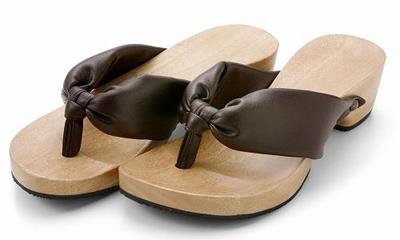Wooden clogs are the simple symbol of Vietnamese women.
T wo parallel and loving boats
With dragon bows and phoenix sterns
Double rows of nails
I carry five boy-lovers per boat
And ten per pair.
But, let you be reproved, you ingrate!
Profiting from me, and forgetting me
What am I?
The above riddle refers to a pair of clogs, footwear imbued with symbolic meaning in Vietnam. One popular legend tells of a pair of stone clogs passed down for generations by a family in Cao Bang, high in Vietnam's northern mountains.
Cao Bang was situated in what was then known as the Vu Dinh region of Van Lang - as the nation was then called. Vu Dinh was divided into nine zones, each of which was governed by a Po, or landlord. Highly competitive, the nine Po organized a contest to determine who was the most skillful.
One Po displayed his skill at planting rice seedlings, another his prowess at building boats, another his ability to grind a ploughshare into a needle in just one day. One was proud of his poetry, another of his skill at building citadels. The last Po showed off his proficiency at carving stone clogs. This Po managed to make a massive pair of stone clogs, which later generations used to span a stream in Ban Thanh village. This unusual bridge still exists today.
Given Vietnam's hot and humid climate and their days spent wading in wet rice paddies or fishing, Vietnamese people usually went barefoot.
At the end of the 10th century, King Le Dai Hanh often wore nothing but a loin-cloth, his feet bare. A Chinese Tong dynasty official, having been snubbed by King Le Dai Hanh, made a disdainful report about the rustic ways of the Vietnamese court. In fact, up until the Tran Dynasty (1225-1400AD), most Vietnamese people went barefoot.Even in those early times, however, clogs were not unknown. Ancient Chinese books like Nam Viet Chi and Giao Chau Ky record that in the third century, the leader of a Vietnamese resistance movement, Ba Trieu, wore a pair of ivory clogs. "Lady Trieu Au with breasts three meters long never married," reports a surprising passage in Giao Chau Ky. "Walking on stilts, she used to wear a type of clogs called Kim De Kich."
Formerly, on cold days, men and women from rural areas would don clogs made from bamboo roots when attending festivals or visiting friends. At home they wrote wooden clogs with vertical straps to protect the toes.
In Phu Yen in south-central Vietnam, people generally made their own clogs. They favored thick soles with slightly turned-up tips. The traps, which attached through a hole in the front and a pair of holes on the sides, were braided from soft cloth. Because the sole was curved at the front, the knot of the front strap did not rub on the ground.
The soles of women's clogs were shaped like hour-glasses, while men's clogs -known as "sampan clogs"- had straight soles. Made of white wood, Phu Yen clogs were left unpainted, while those from the central city of Hue were often painted in black and brown with a pale colored triangle on the side of the sole. Only well-to-do men wore painted clogs. Some areas called clogs don, hence the saying "a foot with a shoe, a foot with a don" to indicate rich people who put on airs.
Up until the 1940s, young pupils at public schools in the southern province of Ben Tre wore clogs. Before the August Revolution in 1945, clogs produced in Hue were called "capital clogs" or guoc kinh. These clogs had soles made from coconut shells or light wood, painted white and gold with embroidered straps. An advertisement from a Hanoi newspaper in the 1940s reads:
"Like finding a needle at the bottom of the sea, now, Flying Horse clogs have been discovered!"

In the 1950s and 1960s, wooden clogs produced in Dong Do village in the Thanh Tri district of Hanoi and Ke Giay in Ha Tay province were taken to 12 Hang Ga street or Bach Mai street in Hanoi to be painted and sold. As the following poem reveals,clogs were considered extremely romantic by young girls of the time:
Clogs long unheard
On the tree-lined streets
And spring comes, apples fall,
I remember your zither sounds.
(To Huu)
By the 1970s, plastic clogs rivaled wooden clogs in popularity. Considered stylish and comfortable, clogs could offer other, more unusual, benefits. Travelers would sometimes bore holes in the wooden soles to hide gold or jewels.
While countless Vietnamese poets have waxed lyrical about the conical hat and traditional ao dai tunic, clogs have been all but ignored by the nation's bards. One exception is the following Ca Dao poem:
"A walk in clogs round the garden in the morning,
Herons are singing and crying
Half for fate, half for their destiny.
(Ca dao poem from south-central Vietnam)
On the other hand, clogs are often the subject of riddles:Two females in colored dresses. Each carrying five males on their backs On the way, talk and chat, And left alone at home: fed up! What is this?
From Ba Trieu's ivory clogs to clogs made of bamboo, wood and plastic, this humble footwear has covered a lot of ground on Vietnam.






































































































